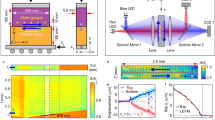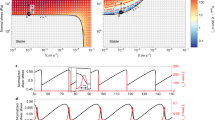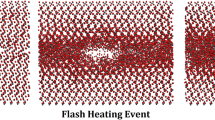Abstract
Earthquakes have long been recognized as being the result of stick–slip frictional instabilities1,2. Over the past few decades, laboratory studies of rock friction have elucidated many aspects of tectonic fault zone processes and earthquake phenomena3,4,5. Typically, the static friction of rocks grows logarithmically with time when they are held in stationary contact6, but the mechanism responsible for this strengthening is not understood. This time-dependent increase of frictional strength, or frictional ageing, is one manifestation of the ‘evolution effect’ in rate and state friction theory5. A prevailing view is that the time dependence of rock friction results from increases in contact area caused by creep of contacting asperities7,8. Here we present the results of atomic force microscopy experiments that instead show that frictional ageing arises from the formation of interfacial chemical bonds, and the large magnitude of ageing at the nanometre scale is quantitatively consistent with what is required to explain observations in macroscopic rock friction experiments. The relative magnitude of the evolution effect compared with that of the ‘direct effect’—the dependence of friction on instantaneous changes in slip velocity—determine whether unstable slip, leading to earthquakes, is possible9,10. Understanding the mechanism underlying the evolution effect would enable us to formulate physically based frictional constitutive laws, rather than the current empirically based ‘laws’11,12, allowing more confident extrapolation to natural faults.
This is a preview of subscription content, access via your institution
Access options
Subscribe to this journal
Receive 51 print issues and online access
$199.00 per year
only $3.90 per issue
Buy this article
- Purchase on Springer Link
- Instant access to full article PDF
Prices may be subject to local taxes which are calculated during checkout




Similar content being viewed by others
References
Brace, W. F. & Byerlee, J. D. Stick-slip as a mechanism for earthquakes. Science 153, 990–992 (1966)
Scholz, C. H. Earthquakes and friction laws. Nature 391, 37–42 (1998)
Marone, C. Laboratory-derived friction laws and their application to seismic faulting. Annu. Rev. Earth Planet. Sci. 26, 643–696 (1998)
Scholz, C. H. The Mechanics of Earthquakes and Faulting 2nd edn (Cambridge University Press, 2002)
Tullis, T. E. Rock friction constitutive behavior from laboratory experiments and its implications for an earthquake prediction field monitoring program. Pure Appl. Geophys. 126, 555–588 (1988)
Dieterich, J. H. Time-dependent friction in rocks. J. Geophys. Res. 77, 3690–3697 (1972)
Dieterich, J. H. & Conrad, G. Effect of humidity on time-dependent and velocity-dependent friction in rocks. J. Geophys. Res. 89 (B6). 4196–4202 (1984)
Dieterich, J. H. & Kilgore, B. D. Direct observation of frictional contacts—new insights for state-dependent properties. Pure Appl. Geophys. 143, 283–302 (1994)
Ranjith, K. & Rice, J. R. Stability of quasi-static slip in a single degree of freedom elastic system with rate and state dependent friction. J. Mech. Phys. Solids 47, 1207–1218 (1999)
Rice, J. R., Lapusta, N. & Ranjith, K. Rate and state dependent friction and the stability of sliding between elastically deformable solids. J. Mech. Phys. Solids 49, 1865–1898 (2001)
Dieterich, J. H. Modeling of rock friction. 1. Experimental results and constitutive equations. J. Geophys. Res. 84 (B5). 2161–2168 (1979)
Ruina, A. Slip instability and state variable friction laws. J. Geophys. Res. 88 (B12). 10359–10370 (1983)
Griggs, D. Hydrolytic weakening of quartz and other silicates. Geophys. J. R. Astron. Soc. 14, 19–31 (1967)
Scholz, C. H. & Engelder, J. T. The role of asperity indentation and ploughing in rock friction–I: Asperity creep and stick-slip. Int. J. Rock Mech. Min. Sci. Geomech. Abstr. 13, 149–154 (1976)
Hirth, J. & Rice, J. On the thermodynamics of adsorption at interfaces as it influences decohesion. Metall. Mater. Trans. A 11, 1501–1511 (1980)
Frye, K. M. & Marone, C. Effect of humidity on granular friction at room temperature. J. Geophys. Res. 107 2309 10.1029/2001JB000654 (2002)
Michalske, T. A. & Fuller, E. R. Closure and repropagation of healed cracks in silicate glass. J. Am. Ceram. Soc. 68, 586–590 (1985)
Stavrinidis, B. & Holloway, D. G. Crack healing in glass. Phys. Chem. Glasses 24, 19–25 (1983)
Ben-David, O., Rubinstein, S. M. & Fineberg, J. Slip-stick and the evolution of frictional strength. Nature 463, 76–79 (2010)
Bowden, F. P. & Tabor, D. The Friction and Lubrication of Solids Ch. I (Oxford University Press, 1958)
Weeks, J. D., Beeler, N. M. & Tullis, T. E. Frictional behavior: glass is like a rock. Eos 72, (Fall Meeting Abs. Supp.). 457–458 (1991)
Kendall, K. Molecular Adhesion and its Applications: The Sticky Universe. (Springer, 2001)
Roche, A. et al. in Ultra Clean Processing of Silicon Surfaces 2000 (eds Heyns, M., Mertens, P. & Meuris, M. ) 76–77, 111–114 (Scitec, 2001)
Iler, R. K. Chemistry of Silica—Solubility, Polymerization, Colloid and Surface Properties and Biochemistry Ch. 1 (John Wiley & Sons, 1979)
Ploessl, A. & Krauter, G. Wafer direct bonding: tailoring adhesion between brittle materials. Mater. Sci. Eng. Rep. 25, 1–88 (1999)
Thoms, B. D., Owens, M. S., Butler, J. E. & Spiro, C. Production and characterization of smooth, hydrogen-terminated diamond c(100). Appl. Phys. Lett. 65, 2957–2959 (1994)
Oliver, W. C. & Pharr, G. M. An improved technique for determining hardness and elastic-modulus using load and displacement sensing indentation experiments. J. Mater. Res. 7, 1564–1583 (1992)
Sader, J. E., Chon, J. W. M. & Mulvaney, P. Calibration of rectangular atomic force microscope cantilevers. Rev. Sci. Instrum. 70, 3967–3969 (1999)
Li, Q., Kim, K. S. & Rydberg, A. Lateral force calibration of an atomic force microscope with a diamagnetic levitation spring system. Rev. Sci. Instrum. 77, 065105 (2006)
Acknowledgements
We thank M.O. Robbins, I. Szlufarska and Y. Liu for discussions. We acknowledge support from the National Science Foundation under awards EAR0810088 and EAR0810192.
Author information
Authors and Affiliations
Contributions
Q.L. performed experiments and obtained the data, and analysed the data with input from all other authors. All four authors wrote this manuscript together. D.G. prepared some of the tips used for the experiments.
Corresponding author
Ethics declarations
Competing interests
The authors declare no competing financial interests.
Supplementary information
Supplementary Information
The file contains Supplementary Figures 1-8 with legends and Supplementary Text. (PDF 591 kb)
Rights and permissions
About this article
Cite this article
Li, Q., Tullis, T., Goldsby, D. et al. Frictional ageing from interfacial bonding and the origins of rate and state friction. Nature 480, 233–236 (2011). https://doi.org/10.1038/nature10589
Received:
Accepted:
Published:
Issue Date:
DOI: https://doi.org/10.1038/nature10589
This article is cited by
-
The Sequence of Heating and Loading Affects Shear Properties of Granite Fractures Under High Temperature
Rock Mechanics and Rock Engineering (2024)
-
Comparing the Tribological Performance of Water-Based and Oil-Based Drilling Fluids in Diamond–Rock Contacts
Tribology Letters (2024)
-
Predicting frictional aging from bulk relaxation measurements
Nature Communications (2023)
-
Statistical laws of stick-slip friction at mesoscale
Nature Communications (2023)
-
How frictional slip evolves
Nature Communications (2023)
Comments
By submitting a comment you agree to abide by our Terms and Community Guidelines. If you find something abusive or that does not comply with our terms or guidelines please flag it as inappropriate.



